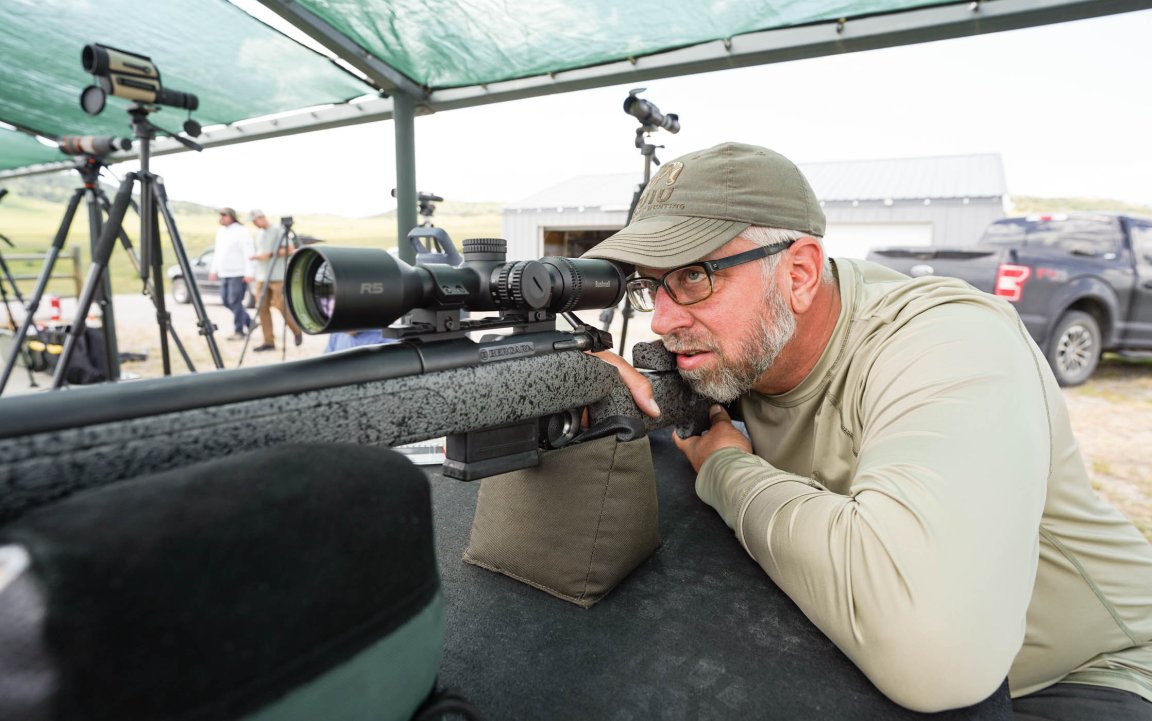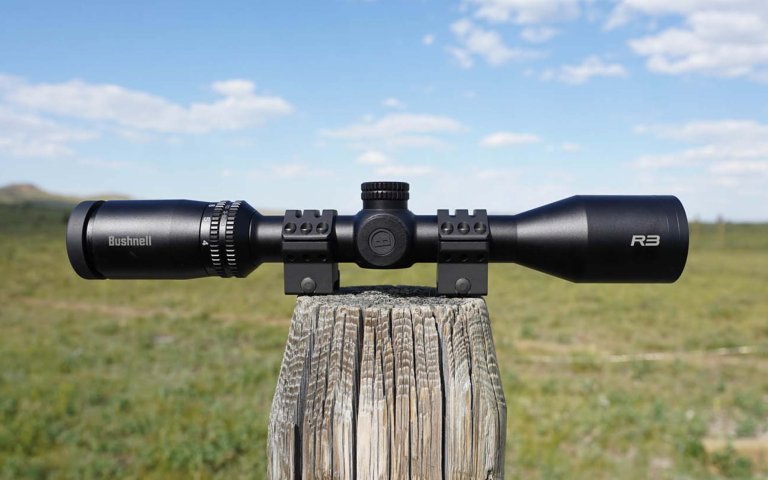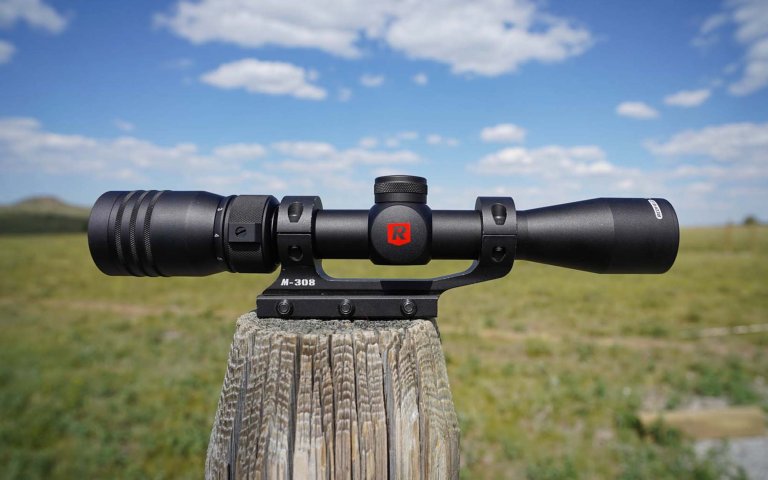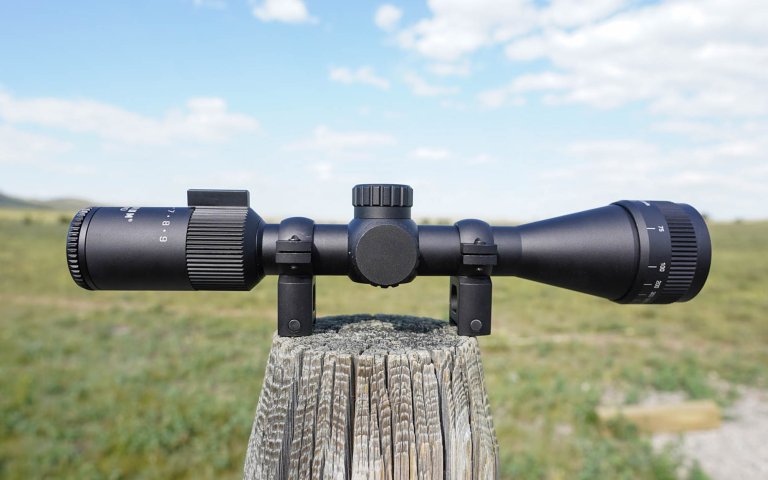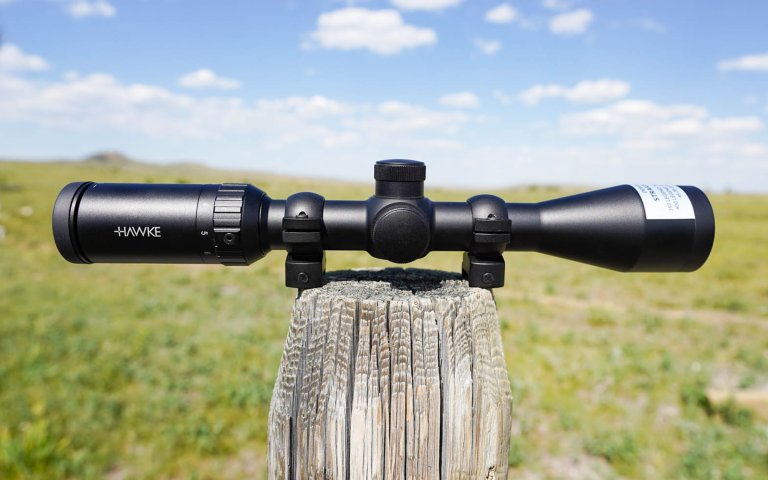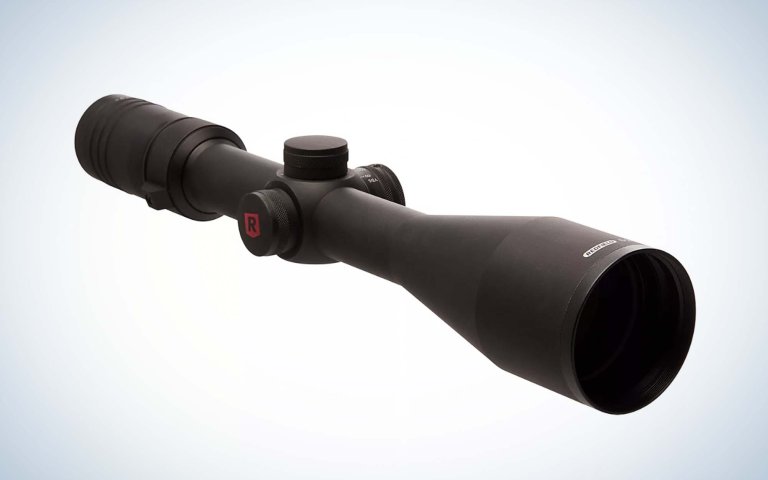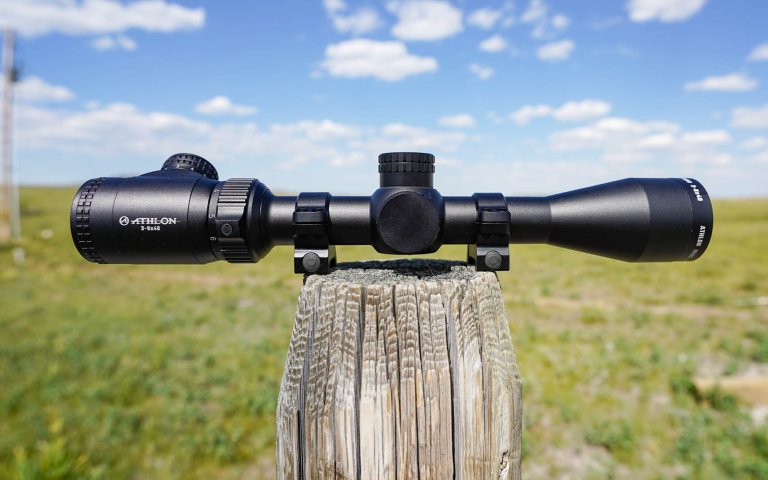We may earn revenue from the products available on this page and participate in affiliate programs. Learn More ›
When is an inexpensive piece of gear a raging bargain, and when is it just cheap? That’s the question we tried to answer in our test of the best rifle scopes under $250.
Optics are among the most expensive pieces of gear in a hunter or shooter’s kit, and the baseline for affordability keeps creeping up, to the extent that few of us bat an eye at a $1,000 rifle scope. That’s simply out of reach for many shooters, but happily there are decent options for a fraction of that price. But some of the cheapest scopes are disposable junk, while others should provide reliable service for years, or until their owners can afford a premium optic.
Our test is designed to separate the forgettable models from ones worth your consideration, and your hard-earned dollars.
- Best Overall: Bushnell R5 4-12×40
- Best for $120: Bushnell R3 3-9×40
- Best Rimfire Scope: Redfield Rebel 2-7×32
- Best Under $100: Monstrum Guardian 3-9×40
- Best Straight-Wall: Hawke Vantage IR Straight-Wall Marksman 3-9×40
- Best High Magnification: Redfield Rebel 6-24×50
- Great Buy Straight-Wall: Athlon Neos Straight-Wall 3-9×40
How We Test Rifle Scopes

These scopes under $250 are put through the same testing protocol as products costing over $1,000. We spend the test on the range evaluating the reticles, turret tracking, turret positivity, zero stop, parallax, and optical performance. We also put each scope through our low-light test that measures how long scopes can see into the darkness. You can read the story Best Hunting Scopes for a full explanation of our test protocol.
Rifle Scopes Under $250: Reviews and Recommendations
Best Overall: Bushnell R5 4-12×40
Pros
- 4x magnification range
- Versatile hunting reticle with elevation and wind holds
- Excellent illumination with off settings between intensity steps
- Reticle references informed by Bushnell Ballistic App
Cons
- Poor turret/reticle tracking
- Turrets tighten noticeably as they bottom out
Score Card
- Optical Performance: Good
- Mechanical Performance: Very good
- Design: Good
- Price/Value: Good
Key Features
- 30mm tube
- Second-plane DOA-LRH800 illuminated reticle
- Capped, re-zeroable turrets tuned to .25 MOA clicks
- 60 MOA windage/elevation adjustment range
- 10 yards to infinity side parallax control
- 6-step red center-dot illumination
- Covered by Bushnell’s “Ironclad” fully transferable lifetime warranty
- Price: $239
Bushnell packed a ton of features into its new R5 line. The 4-12×40 in our test has a very good center-dot red LED illumination, and the side parallax focuses targets as close as 10 yards, making this a good air gun or rimfire scope. The second-plane reticle has decent references out to 800 yards. And the short (11.5-inch) scope nicely fits AR-pattern rifles or youth guns.

The accessible price (MSRP is $239 but you can probably find this for under $200) makes it a smart choice for a wide variety of hunting and shooting platforms, especially for budget gunners.
But there’s a cost to all those amenities in a budget scope, and users will pay it in creaky controls. We noticed that the zoom dial turns easily at lower magnifications, but then tightens toward higher powers. Same with the turrets; they turn easily and sharply in the middle of their adjustment range, but as they near the higher and lower ends of their travel, they start to stick. That’s a sign of cheap erector components, and we worry that users who really force the turrets could end up breaking them.
The Bushnell’s glass was better than we expected; it posted a very good resolution score and the 40mm scope did okay in low-light evaluations.
The DOA reticle is decent, offering MOA-based holds out to 800 yards and windage holds in both 5 and 10 mph right-angle winds. But the references are very fine, and some testers noted that they disappear against cluttered backgrounds.
Still, for a hunter who wants a scope with lots of moving parts and amenities, the R5 is priced right, and Bushnell’s lifetime warranty is a good backstop in case any of those moving parts stop moving. Given its abundant hunting chops for a very fair price, we awarded the R5 with our great buy award for the hunting-scope category.
Best for $120: Bushnell R3 3-9×40
Pros
- 3x magnification range
- At about $120, a good value
- Bullet drop holds informed by Bushnell ballistic app
Cons
- Fixed parallax causes some focus issues
- No illumination
- Spongy turret tactility
Score Card
- Optical Performance: Fair
- Mechanical Performance: Good
- Design: Fair
- Price/Value: Very good
Key Features
- 1-inch tube
- Second-plane DOA-QBR reticle
- Capped re-zeroable turrets tuned to .25 MOA clicks
- 65 MOA windage/elevation adjustment range
- Reticle references out to 600 yards
- Covered by Bushnell’s “Ironclad” fully transferable lifetime warranty
- Price: $20
With its new R3 family of optics, Bushnell has a new entry-level scope that offers some very appealing attributes for a beginning hunter or a shooter on a budget.
First is its price. For a little over $100 you get an honest scope with enough reticle references to make informed shots at middle distances. The glass is murky but it’s good enough for 90 percent of a hunter’s time in the field. The re-zeroable turrets are mushy but serviceable. In short, it’s a solid effort.
We’ve been fans of Bushnell’s DOA reticle since it came on the scene in the brand’s Trophy line of scopes nearly 20 years ago, and the combination of bullet-drop references and simple windage marks makes it a fast, simple, and effective hunting reticle. With a 100-yard zero, shooters have four 1 MOA dots for elevation holds, and the top of the extended duplex post provides a 600-yard reference. It’s not overly precise, but at least the references are informed by ballistic parabolas. Users can further fine-tune their bullet velocities to the reticle by pairing it with the free Bushnell Ballistic App.
We worry about the durability of this scope, though it was one of the few budget scopes that didn’t fog after a freeze-thaw test. Additionally, the Bushnell’s fixed parallax limits its utility at both very short and very long distances. But those are relatively minor quibbles for a scope that would be at home on a first squirrel gun or deer rifle.
Best Rimfire Scope: Redfield Rebel 2-7×32
Pros
- Few exposed controls
- At under $100, an accessible price
- Decent rimfire scope
- According to Academy, covered by lifetime replacement warranty
Cons
- Poor construction
- Narrow utility
Score Card
- Optical Performance: Poor
- Mechanical Performance: Fair
- Design: Fair
- Price/Value: Good
Key Features
- 1-inch tube
- Second-plane non-illuminated duplex reticle
- Re-zeroable capped turrets tuned to .25 MOA clicks
- 30 MOA internal windage and elevation adjustment
- 50-yard fixed parallax
- 12.6 ounces
- Price $99
My delight at having Redfield back in our optics test faded as its rifle scopes underwhelmed on our evaluation range. No scope failed any task, but of the three in our field, none particularly wowed us or reminded us of this brand’s grand heritage.
Redfield is one of the former greats of the American optics industry, going afield with at least two generations of sportsmen. But then the rise of very good Japanese optics, more affordable at the time than the American-made glass, took market share, and European brands made a successful bid for American hunters. Venerable domestic brands like Redfield, Weaver, and Bausch + Lomb faded into the background. Leupold made a short play for Redfield, which is now the house optics brand for Academy Sports.
The 2-7×32 Redfield is the most niche of the trio. There’s not a lot to this scope, but at a $99 retail price, it’s not intended as a utility player. Instead, it’s intended as a first scope for a kid’s .22, or maybe a light-recoiling deer rifle. With that use-case in mind, the Rebel is adequate, but it’s not going far beyond its low expectations.
The duplex reticle is clean and standard, and the turrets, tuned to .25 MOA clicks, actually moved with more authority and tactility than we expected. An even more surprising attribute is that the turrets are easily re-zeroed.
But the Redfield’s glass is pretty cringy, and given that our sample fogged up after a freeze-thaw test, we worry about the overall durability of the build. But if you treat it well, it should get a few years of use before buyers graduate out of the entry-level market into their next scope, which given its renaissance might well be a Redfield.
Best Under $100: Monstrum Guardian 3-9×40
Pros
- Lots of attributes for a price-point scope
- Re-zeroable turrets
- Useful throw lever
- At $50, a screaming bargain
- Ships with shoot-through rings and flip-up lens caps
Cons
- Poor turret indexing
- Some lens fogging
- Squinty glass
Score Card
- Optical Performance: Fair
- Mechanical Performance: Fair
- Design: Fair
- Price/Value: Good
Key Features
- 1-inch tube
- Second-plane “MOA-Dot” reticle
- Red and green full-reticle illumination
- Capped turrets tuned to .25 MOA clicks
- Objective-bell parallax control, 25 yards to infinity
- Covered by non-transferable lifetime warranty
- Price: $69
How on earth can a manufacturer bring to market a serviceable rifle scope for $50? And include a set of rings with the optic? That’s the question we’ve been asking for a couple of years, as we’ve seen the brand Monstrum selling boatloads of scopes through Amazon’s online retail store. So we invited Monstrum to our test, partly to prove to ourselves that their cheap optics aren’t actually a bargain.

So color us surprised to find that their 3-9×40 Guardian isn’t that bad. Okay, it flunked the low-light test and testers reported headaches and squints after a session behind the scope, but on matters that matter for a rifle scope, the Monstrum fared decently. Its turrets tracked perfectly with its reticle and its illumination fired up the reticle in both greens and reds. Its objective-bell parallax is clunky, but focused targets from about 35 yards to way out there.
There are some significant durability issues with this scope. Its internal lenses fogged after a freeze-thaw test, and we noticed an unsettling vibration in the erector system, like the buzz of a mouth harp, if we tapped the scope. The reticle, which Monstrum calls an MOA-Dot, is useless for anything but crosshair aiming, the “dots” looking as lumpy and indistinct as ants on a log.
But, as testers kept saying, “What do you expect for a $50 scope?” Truth is, we expected a lot less. With its lifetime warranty, the Monstrum represents a pretty appealing entry-level scope for a rimfire or air gun.
Best Straight-Wall: Hawke Vantage IR Straight-Wall Marksman 3-9×40
Pros
- Reticle has easy-to-see distance references
- Good mounting dimensions
- Handy illumination
- At about $220, a fair price
Cons
- Turrets are small and indistinct
- Turrets aren’t re-zeroable
- Turrets aren’t properly indexed
Score Card
- Optical Performance: Good
- Mechanical Performance: Very good
- Design: Good
- Price/Value: Very good
Key Features
- 1-inch tube
- Second-plane Straight-Wall Marksman BDC MOA-based reticle
- Capped turrets tuned to .25 MOA values
- 100 MOA total windage/elevation adjustment range
- 10-step red/green illumination
- Optimized for 450 Bushmaster, .45/70 Gov’t, 350 Legend, 400 Legend
- Parallax set at 100 yards
- Covered by non-transferable lifetime warranty
- Price: $200
This scope absolutely ruled our four-scope straight-wall cartridge shoot-off, thanks to a clear and useful reticle that literally gives shooters specific hold-over directions. You want to zero at 100 yards? The reticle has a 100-yard reference, with the number etched on the reticle. There are other numeric etching at 150, 200, 250, and 300 yards. I know what you’re saying: all those numbers probably clutter the view.
You’re not wrong; the references are a little busy. But our testers found them to be fast, precise, and idiot-proof.
“I was skeptical about lobbing a 300-grain bullet out at 300 yards, but I just held where the scope told me and rang steel on my first shot,” noted tester Dale Manning. “It’s precise, but it’s also really fast in real-world field conditions.”
The very specific references that make this the best straight-wall cartridge scope in our test limit its wider utility. Those etched bullet drops aren’t going to help a rimfire shooter or a hunter who’s using a .30/06 or 6.5 Creedmoor. And testers hated the Hawke’s turrets, which are small and hard to turn and lack indexing.
But if you’re in the market for a scope that will lob bullets surprisingly precisely, from both 350 and 400 Legends, 360 Buckhammer, 450 Bushmaster, and .45/70 Gov’t, this is absolutely the scope for you.
Read Next: Best Scopes for Straight Wall Cartridges
Best High Magnification: Redfield Rebel 6-24×50
Pros
- At $249, a very accessible price
- 50mm objective useful for low-light hunting
- MOA-based reticle useful for mid-range precision shooting
- Daylight-bright illumination
- According to Academy, covered by lifetime-replacement warranty
Cons
- Mushy turrets
- Durability concerns
Score Card
- Optical Performance: Poor
- Mechanical Performance: Good
- Design: Fair
- Price/Value: Excellent
- Price: $250
Key Features
- 30mm tube
- Second-plane “Accuranger” hash-style reticle
- Capped turrets tuned to .25 MOA clicks
- 11-step red illumination
- 50 yards to infinity parallax
As noted elsewhere, it’s nice to see Redfield’s distinctive red badge in our test, and this iteration of the Rebel scored better across the board than the rimfire scope. Of course, it’s more than twice the price, but we found a lot to like for $250, starting with the configuration.
This is a bit of an oddball for the versatile scope category, since you’d expect a 6-24X scope in the precision field. But there’s not enough talent in the Redfield to compete with true precisions scopes, and it’s a little overbored for many hunting situations. Still, if you’re a low-light hunter who wants simple reticle references, you can do worse than this big scope with both illumination and parallax.
The glass is underwhelming, and we found the turrets tinny. The Redfield was one of several budget scopes that fogged when subjected to a freeze-thaw test. But the scope tracked well, and does double duty as a mid-range hunting scope or a target optic. The close focus and versatile reticle make it a decent choice for a precision rimfire scope.
As we noted, Redfield is the house brand for Academy Sports, and frequent shoppers may well find this on sale for significantly less than its listed price, making it an even better deal on a big, powerful optic.
Read Next: Best Hunting Scopes
Great Buy Straight-Wall: Athlon Neos Straight-Wall 3-9×40
Pros
- With proper zero and bullets, reticle references are fast and precise
- Low mounting dimension fit a variety of rifle receivers
- One of few entry-level straight-wall scopes with illumination
- At about $175, a fair price
Cons
- Illumination module is large and ungraceful
- Reticle references are small and imprecise
- Spongy turret clicks
Score Card
- Optical Performance: Fair
- Mechanical Performance: Good
- Design: Good
- Price/Value: Very good
Key Features
- 1-inch tube
- Second-plane BDC 300 Straight-Wall reticle
- Ballistic drops tuned to specific straight-wall calibers and bullets
- Red LED center-cross illumination
- Capped turrets tuned to .25 MOA values
- 80 MOA total windage/elevation adjustment range
- Parallax set at 100 yards
- Covered by Athlon’s fully transferable lifetime warranty
- Price: $180
None of the straight-wall scopes in our mini test are particularly pricey, but this model from Athlon offers a number of appealing attributes, places heavy bullets on target out to 300 yards, and costs around $175, making it the best value in our collection.
Like its competitors, the Neos doesn’t have memorable glass or controls. But that’s not why you’re buying this. You are looking for an inexpensive get-‘er-done optic, and the Athlon lives up to that expectation. Its BDC 300 Straight-Wall illuminated reticle lives up to its promise as a decent 300-yard punkin-lobber. The reticle, basically a modified duplex, also has windage hashes for holds in 5- and 10-mph right-angle winds, but we didn’t test the veracity of those references.
Like the other second-plane reticles in this mini-test, the Athlon’s reticle drops work only at the highest magnification, but at 9-power the scope handles well, providing good magnification of the target and decent light transmission. The reticle, though, is too fine; we’d like to see the elevation stadia and bullet-drop dots a little heavier. Red illumination helps visibility, but the illumination module, awkwardly located on the scope’s eyepiece, is clunky and graceless, though easy to reach to turn on and off.
The Athlon’s capped turrets are fairly crisp, and are re-zeroable, though we’d like to see bolder and more visible indexing on the dials. The scope’s parallax is fixed at 100 yards. The 1-inch main tube has plenty of space for various mounting options, and the 40mm objective allows for low-profile mounting. While the scope’s reticle is tuned to very specific straight-wall cartridge bullets (250-grain Hornady FTX in 450 Bushmaster, 325-grain FTX in .45/70 Gov’t, 150-grain Winchester Extreme Point in 350 Legend, and 200-grain Remington Core Lokt in 360 Buckhammer), the scope would be fine on a rimfire or modern center-fire rifle.
At $179 retail price, we reckoned the Neos brings a lot to the straight-wall party, and wins our great buy award in this small and tightly defined category of versatile scope.
How to Choose an Inexpensive Scope

Glass and Coatings
Crappy glass doesn’t always reveal itself right away. A scope that looks clear and bright in a sporting-goods store can give you a headache once you get it on a gun and into the light of day. Generally speaking, established brands have better glass and coatings, simply because even their budget products benefit from the optical engineering and proprietary coatings that their more premium lines enjoy.
Durability
How smoothly power-changing dials and turrets turn is a pretty good indication of the build of a scope. Do controls move like they have sand in their gears? That’s a sign of poor construction and components that will fail in the field. On the other hand, do turret caps fit tightly, and do dials turn smoothly across their range? That’s an indication of solid construction.
Warranty
Lastly, check out the brand’s warranty. It’s become fashionable in the optics industry to offer fully transferable lifetime warranties, which is a great safety net for buyers of entry-level products. But read online reviews. Do brands really honor those warranties, or do they throw up unexpected hassles and complications when you make a warranty claim? The best warranty is one you never use, but it’s gratifying to know that if something fails in a budget scope, the manufacturer has your back.
Final Thoughts
The ultimate calculus about whether you chose a budget optic should be durability. Will the optic hold up to the typical abuse of the range and field?
Truth is, it’s hard to know. Even $2,000 optics will fail in certain situations. But our test of the best budget scopes looked hard at the durability and construction quality that should be top of mine for anyone in the market for an entry-level scope.
